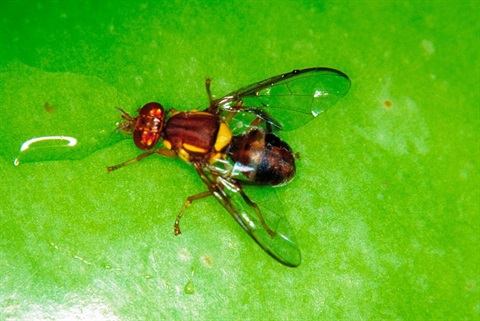
Council is asking residents to be on the lookout for the Queensland Fruit Fly (QFF) in coming months and help prevent its spread, after a detection of the fly in Silvan this month.
QFF was detected in the Yarra Valley in February 2018 and again in January 2019. Containment and eradication treatments were then put in place by private landowners.
Unfortunately, the fruit fly has again been detected in Silvan. Council was notified of the detection in March. Residents in the immediate surrounding area are being notified and provided with information on how to prevent the pest spreading.
The QFF is active in fruiting season, though populations increase in spring when temperatures rise above 16 degrees. They can remain active in autumn and winter in warmer weather.
Council and Agribusiness Yarra Valley will work with the landowners to contain and eradicate any QFF.
What is the Queensland Fruit Fly and why is it an issue in the Yarra Valley?
The Queensland Fruit Fly is a horticultural pest, which lays eggs in fruit and vegetables.
The damaged fruit and veggies rot inside while the eggs mature into larvae, making the produce inedible and unsaleable.
Fruit fly populations can increase in number quickly, and the damage to fruit can extend into neighbouring properties, or even across the region.
Common fruit hosts for fruit flies include:
• oranges and lemons,
• apples, pears and quince
• peaches, plums, nectarines and apricots,
• tomatoes and eggplants,
• chillies and capsicums,
• persimmons, loquats, figs, and kiwis,
• strawberries, cherries, blueberries, blackberries and raspberries
• prickly pear, pomegranates, and passion fruit
The Yarra Valley has valuable horticultural production properties and great home gardens with edible produce which is worth protecting.
How can I help prevent the Queensland Fruit Fly from spreading?
Residents with fruit trees can prune their trees to a reachable height, harvest fruit quickly and keep an eye out, as the fruit fly looks for ripe fruit to breed.
Good ways of preventing the spread of the Queensland Fruit Fly are:
- Pruning fruit trees in gardens to a manageable size. Smaller fruit trees are easier to implement fruit fly controls on and are more manageable for home gardeners. Infestation can occur when fruit on high branches are left unharvested. The best time of year to prune fruit trees is in late winter and early spring, when trees are generally dormant.
- Picking fruit before it falls from the tree. Damaged and fallen fruit can become a refuge for fruit fly maggots. Dispose of all fallen or damaged fruit properly to minimize the risk of spreading QFF.
- If you have fruit grown in areas where QFF exists and are returning to the area, leave it behind, eat it all or cook it before bringing it into the Yarra Valley to protect the area.
- Install QFF traps if you are in the Yarra Valley, and monitor each week for flies.
- Apply fruit fly bait on trees and leaves if you’ve had a detection in your area. The bait will kill flies.
Infested fruit or vegetables can be microwaved to kill maggots. Alternatively, fruit and vegetables can be frozen for two days to kill off maggots and larvae before they are disposed of.
It’s important that infested fruit is destroyed, so that fly larvae don’t develop into adults and spread across the valley.
Do not compost infested fruit, but keep a sample for testing in a sealed container in your fridge.
QFF traps and bait are available at garden centres or online.
What has Council done to prevent the spread of the fruit fly?
Agribusiness Yarra Valley and Yarra Ranges Council received State Government grants from the Managing Fruit Fly – Regional Grants Program during 2017-20 to help prevent QFF spread.
This grant funded programs including fly trapping programs delivered by Agribusiness Yarra Valley, school education sessions, community information workshops and Council auditing and removing potential host trees on public land.
This resulted in the removal of hundreds of fruit trees from public land across Yarra Ranges. These trees posed a risk of QFF spread through dropped fruit.






